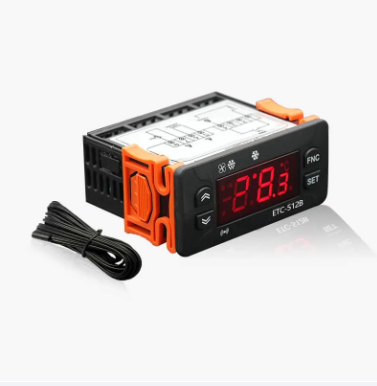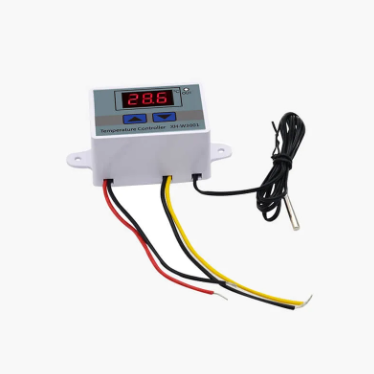Ջերմաստիճանի կարգավորման կարևոր դերը տաքացման, օդի փոխանակման և սառեցման ոլորտներում և սառեցման համակարգերում
Ներկայումս տարածքների ջերմաստիճանի ճշգրիտ վերահսկումը ամբողջությամբ անցնում է հարմարավետության պարզ հարցերից: Իրականում դա ազդում է այդ համակարգերի աշխատանքի արդյունավետության, անվտանգության և տևականության վրա: Թվային ջերմաստիճանի կարգավորիչներ այսօր գրեթե անհրաժեշտ են դարձել ներքին միջավայրի ճիշտ կառավարման, ցուրտ պահելու անհրաժեշտ իրերի պահպանության և էներգիայի վատնման կրճատման համար: Այս սարքերը հանդիպում են խանութների սառույցներում, խոշոր արդյունաբերական սառեցման համակարգերում և սովորական տաքացման/սառեցման սարքերում: Դրանց արժեքը հնարավորությունն է նվազագույնի հասցնել ջերմաստիճանի տատանումները, որպեսզի ամեն ինչ հարմարավետ աշխատի առանց մեքենաների վրա ճնշում գործադրելու:
Շրջակա միջավայրի և կանոնարկման պահանջների աճի հետ մեկտեղ ավելի խելացի և ճկուն կառավարման համակարգերի կարիքը այլևս չի կարող անտեսվել: Թվային կառավարիչները ապահովում են այն ինտելեկտը և ճկունությունը, որոնք անհրաժեշտ են տարբեր տիպի շենքերում և ցուրտ շղթայի կիրառություններում առաջացած մարտահրավերներին հաղթահարելու համար:
Ինչու են թվային կառավարիչները գերազանցում անալոգային համակարգերին
Ճշգրտություն և արձագանքում
Թվային ջերմաստիճանի կառավարիչները անալոգային ջերմաստիճանաչափերից տարբերվում են նրանով, որ դրանք օգտագործում են սենսորների տվյալներն ու ալգորիթմական տրամաբանությունը՝ անընդհատ ճշգրտելու համակարգի արդյունքները: Այս մոտեցումը ապահովում է ավելի կայուն և ճշգրիտ ջերմաստիճանային տիրույթ, որը հատկապես կարևոր է տվյալների կենտրոններում, դեղատներում և սննդամթերքի պահպանման գործում:
PID (համաչափ-ինտեգրալ-դիֆերենցիալ) ալգորիթմների միջոցով թվային կառավարիչները նվազեցնում են ավելցուկային և թերի կարգավորումը՝ պահելով ջերմաստիճանը նեղ, սահմանված սահմաններում: Այս մոտեցման շնորհիվ սենյակի միկրոկլիման ավելի կայուն է լինում, իսկ էներգիայի ծախսերը՝ ցածր:
Իրաժամանակ հսկում և հետադարձ կապ
Թվային ջերմաստիճանի կառավարման առանձնահատկությունը իրական ժամանակում հսկողությունն է: Կառավարիչները ցուցադրում են ապարանջանի ջերմաստիճանի ցուցման տվյալներ և կարգավիճակի թարմացումներ, որոնք թույլ են տալիս տաքացման, օդափոխման և սառեցման տեխնիկական մասնագետներին վաղ հայտնաբերել խնդիրները: Ավելի բարդ մոդելները նաև տեսանելի և ձայնային զգուշացումներ են ունենում՝ խափանումների, հոսանքի կորստի կամ կրիտիկական շեղումների դեպքում:
Ջերմաստիճանի տատանումների հսկողության հնարավորությունը ժամանակի ընթացքում օգնում է խնդիրները ախտորոշել դրանց ավելանալուց առաջ, ինչը նվազեցնում է դադարներն ու սպասարկման ծախսերը:
Կիրառություն տաքացման, օդափոխման և սառեցման համակարգերում
Առևտրային տաքացման, օդափոխման և սառեցման տեղադրումներ
Մեծ գրասենյակային շենքերում, հիվանդանոցներում և օդանավակայաններում տաքացման, օդի փոխանակման և կլիմայական համակարգերը ստիպված են հարմարվել փոփոխվող զբաղվածության մակարդակներին և արտաքին եղանակային պայմաններին: Թվային ջերմաստիճանի կարգավորիչը հնարավորություն է տալիս կատարել գոտիների կոնկրետ ճշգրտումներ, որտեղ յուրաքանչյուր տարածք կարող է պահպանել իր սեփական կլիմայական պայմանները՝ էներգիայի խնայողության և հարմարավետության համար:
Գոտիավորումը զուգակցված զբաղվածության սենսորների և թվային կառավարիչների հետ բարելավում է համակարգի արձագանքումը և սահմանափակում է ավելորդ էներգասպառումը:
Արդյունաբերական և մանրածախ սառեցման համակարգեր
Սուպերմարկետներում, սառը պահեստարաններում և ռեստորաններում սառեցման սարքերը պետք է հետևեն խիստ ջերմաստիճանային պահանջներին: Թվային ջերմաստիճանի կարգավորիչը ապահովում է թթվածին պարունակող ապրանքների կայուն ջերմաստիճանների պահպանումը, նվազեցնելով կոտրվածքները և կարգավորման ռիսկերը:
Այդ համակարգերը կարող են կարգավորվել ջերմաստիճանի պատմությունը գրանցելու համար, որը թույլ է տալիս ավելի լավ հետևելիություն ապահովել հաշվապահական ստուգումների և համապատասխանության համար, հատկապես սննդի և դեղատների արդյունաբերություններում:
Կլիմայական վերահսկվող պահեստավորման և պահեստարաններ
Շատ զգայուն ապրանքներ, ինչպես օրինակ՝ էլեկտրոնիկան, քիմիկատները և բժշկական պարագները, պահվում են վերահսկվող միջավայրում: Թվային կառավարիչները պահում են այդ միկրոկլիմաները բարձր ճշտությամբ, իսկ որոշ համակարգեր նույնիսկ աջակցում են հեռական մուտքը՝ պարամետրերը կարգավորելու կամ անմիջապես արձագանքելու համար զգուշացումներին:
Հիմնարար հնարավորություններ, որոնք բարելավում են համակարգի աշխատանքը
Երկկողմանի ելք տաքացման և սառեցման համար
Շատ թվային ջերմաստիճանի կառավարիչներ ունեն երկկողմանի ելքի կարգավորում: Սա նշանակում է, որ դրանք կարող են անկախ կերպով միացնել տաքացման և սառեցման գործառույթները՝ հնարավորություն տալով անցումային կլիմաների և խառը բեռնվածության տարածքների համար, որտեղ պայմանները հաճախ փոխվում են:
Ծրագրավորվող ժամանակացույցներ
Թվային կառավարիչները թույլ են տալիս օպերատորներին կարգավորել ջերմաստիճանի ժամանակացույցները՝ կախված օրվա ժամերից, բնակեցման օրինաչափություններից կամ արտաքին եղանակային պայմաններից: Օրինակ՝ HVAC համակարգերը կարող են նվազեցնել արտադրողականությունը գիշերը կամ շաբաթականներին՝ էներգիա խնայելու նպատակով՝ ներքին պայմանները չխախտելով:
Այս ծրագրավորելի գործառույթները ձեռքով կատարվող կարգավորումների համեմատ ավելի բարձր արդյունավետություն են ապահովում և օգնում են նվազեցնել շահագործման ծախսերը:
Շենքի կառավարման համակարգերի հետ համատեղելիություն
Ժամանակակից թվային ջերմաստիճանի կարգավորիչը հաճախ աջակցում է կենտրոնացված շենքի կառավարման համակարգերի (BMS) ինտեգրմանը: Modbus, BACnet կամ Ethernet/IP նման կապի պրոտոկոլների միջոցով կարգավորիչները կիսվում են ջերմաստիճանի տվյալներով և արձագանքում են հրամաններին ավելի ընդարձակ ավտոմատացման ենթակառուցվածքում:
Այս կապը կարևոր է մեծ համալիրների համար, որտեղ անհրաժեշտ է կենտրոնացված կառավարում և հսկում հարյուրավոր գոտիներում:

Էներգախնայողության և ծախսերի կրճատման օգուտներ
Սարքավորումների հաճախադեպ կոճապտումը
Կոմպրեսորների կամ ջեռուցման սարքերի հաճախադեպ կոճապտումը բերում է մաշվածության, սարքավորումների նույնացման աճին և կարճացնում է սարքավորումների ծառայության ժամանակը: Թվային կարգավորիչները կոճապտումը նվազեցնում են ջերմաստիճանի կայուն պահումով, թույլատվելով բաղադրիչներին ավելի արդյունավետ աշխատել:
Սա ոչ միայն էներգիան է պահպանում, այլ նաև երկարացնում է կարևոր օդափոխման և սառեցման սարքերի ծառայության ժամկետը
Բեռնվածության հավասարակշռում և պահանջարկի պատասխան
Այն առևտրային կազմակերպումներում, որտեղ էներգիայի արժեքը կարող է տատանվել կախված պահանջարկից, թվային ջերմաստիճանի կարգավորիչները կարող են մասնակցել պահանջարկի պատասխանման ծրագրերին: Նրանք մի փոքր ճշգրտում են ջերմաստիճանի ցուցանիշները գագաթնային օգտագործման ընթացքում՝ նպաստելով բեռնվածության հավասարակշռմանը՝ առանց նկատելի հարմարավետության կորստի
Ընդգրկվելով այս ծրագրերում՝ կարող եք ստանալ ֆինանսական խրախուսում և կրճատել կոմունալ վճարները։
Շրջակա միջավայրին հարմարվող ուսուցում
Որոշ առաջադեմ թվային կարգավորիչներ հագեցած են հարմարվող ուսուցման հնարավորություններով: Նրանք կարող են վերլուծել ջերմաստիճանի պատմական տվյալներն ու համակարգի վարքը՝ ավտոմատ կերպով արդյունավետությունը բարելավելու համար ժամանակի ընթացքում: Այս հնարավորությունը հատկապես օգտակար է դինամիկ միջավայրերում, որտեղ բնակեցվածությունը կամ արտաքին ջերմաստիճանները զգալիորեն տարբերվում են
Հեռակառավարում և կապի տարբերակներ
Wi-Fi և ամպային ինտեգրում
Այսօրվա թվային ջերմաստիճանի կարգավորիչները հաճախ աջակցում են Wi-Fi կամ Ethernet միացումը: Սա հնարավորություն է տալիս հեռակառավարում՝ սմարթֆոնների կամ համակարգիչների միջոցով, ինչը թույլ է տալիս սենյակների կառավարիչներին հսկել, կարգավորել և հնարավոր խնդիրները վերացնել ցանկացած վայրից: Ծանուցումներ կարող են ուղարկվել իրական ժամանակում՝ սարքավորումների անսարքության կամ միջավայրի փոփոխությունների դեպքում արագ արձագանքելու համար:
Ամպային վահանակները տրամադրում են պատմական տվյալների միտումներ և համակարգերի վերլուծություն, որն էլ հնարավորություն է տալիս կայացնել տվյալների հիման վրա հիմնված որոշումներ:
Ծրագրային ինտերֆեյսներով
Շատ արտադրողներ այժմ առաջարկում են հեռակառավարման համար հավելվածներ, որոնք թույլ են տալիս հեշտությամբ կարգավորել և հսկել կարգավորիչները: Այս հարթակները հեշտացնում են համակարգերի կարգավորումը և կառավարումը՝ դարձնելով դրանք հասանելի նաև մասնագիտացված մասնագետների համար չհանդիսացող անձնակազմի համար:
Ծրագրային հարթակների միջոցով ջերմաստիճանի կարգավորումը, զգուշացնող հաղորդագրությունները և ախտորոշումները հասանելի են մեկ կոճակի սեղմմամբ:
Ձեր համակարգի համար ճիշտ թվային կարգավորիչի ընտրություն
Մուտքային և ելքային համատեղելիություն
Ցանկալի ընտրություն թվային Ջերմոսահաղորդակց սկսվում է համատեղելիությամբ: Կառավարիչը պետք է աջակցի ձեր ընտրած սենսորներին (RTD, ջերմազույգ և այլն) և ռիլեյի տեսակներին (մեխանիկական, պինդ մարմնի): Լարման և ամպերաժի վարկանիշները պետք է համընկնեն կլիմայական կամ սառեցման բաղադրիչների հետ:
Կառավարման ռեժիմ և Ֆունկցիաներ
Կլիմայական համակարգերի համար հաճախ իդեալական է այն կառավարիչը, որն աջակցում է PID-ին և ավտոմատ կարգավորմանը: Ծրագրավորվող աճման/պահման պրոֆիլները, հիստերիզի կառավարումը և օգտագործողի կողմից սահմանված զգուշացումները կարող են ավելացնել արժեքը՝ կախված կիրառությունից:
Տարածքի հստակ պահանջների հասկանալը՝ ինչպես օրինակ մի քանի գոտիների կառավարման կամ խոնավության ինտեգրման կարիքը, կարող է օգնել ընտրության գործում:
娿ական հեռավորություն
Սառեցման կամ փողոցային կլիմայական կայանքներում օգտագործվող կառավարիչները պետք է ունենան դիմացկուն փակ տիպի վարկանիշ, ինչպես IP65 կամ NEMA 4X: Սա պաշտպանում է սարքը խոնավությունից, փոշուց և ջերմաստիճանային սրտաճաշակներից՝ ապահովելով երկարաժամկետ հուսալիություն:
Հաճախ տրամադրվող հարցեր
Ինչպե՞ս է թվային ջերմաստիճանի կառավարիչը բարելավում էներգահամարժեքությունը կլիմայական համակարգերում:
Նույնական պահպանելով թիրախային ջերմաստիճանները, համակարգի ցիկլերի նվազումը և ծրագրավորվող ժամացուցակների հնարավորությունը, թվային կառավարիչները օգնում են HVAC համակարգերին ավելի արդյունավետ աշխատել և էներգիայի ավելի քիչ սպառում ունենալ:
Կարո՞ղ է թվային ջերմաստիճանի կառավարիչը տեղադրվել ավելի հին HVAC համակարգերում:
Այո, շատ թվային կառավարիչներ նախագծված են առկա համակարգերում տեղադրելու համար, եթե հաստատված է սենսորների և ելքերի համատեղելիությունը:
Անհրաժեշտ է արդյոք կառավարիչը միացնել ինտերնետին:
Ոչ, սակայն ինտերնետի միացումը առաջարկում է կարևոր առավելություններ, ինչպես օրինակ՝ հեռակա հսկումը, զգուշացնող ծանուցումները և անցած աշխատանքի տվյալների հասանելիությունը:
Ի՞նչ տեսակի սպասարկում է անհրաժեշտ թվային ջերմաստիճանի կառավարչի համար:
Սենսորների կալիբրման պարբերական ստուգումները, ծրագրային ապահովման թարմացումները և միացումների ամրությունը պահպանելը սովորաբար բավական է ամենաբարձր արդյունավետությունը ապահովելու համար:
Բովանդակության աղյուսակ
- Ջերմաստիճանի կարգավորման կարևոր դերը տաքացման, օդի փոխանակման և սառեցման ոլորտներում և սառեցման համակարգերում
- Ինչու են թվային կառավարիչները գերազանցում անալոգային համակարգերին
- Կիրառություն տաքացման, օդափոխման և սառեցման համակարգերում
- Հիմնարար հնարավորություններ, որոնք բարելավում են համակարգի աշխատանքը
- Էներգախնայողության և ծախսերի կրճատման օգուտներ
- Հեռակառավարում և կապի տարբերակներ
- Ձեր համակարգի համար ճիշտ թվային կարգավորիչի ընտրություն
-
Հաճախ տրամադրվող հարցեր
- Ինչպե՞ս է թվային ջերմաստիճանի կառավարիչը բարելավում էներգահամարժեքությունը կլիմայական համակարգերում:
- Կարո՞ղ է թվային ջերմաստիճանի կառավարիչը տեղադրվել ավելի հին HVAC համակարգերում:
- Անհրաժեշտ է արդյոք կառավարիչը միացնել ինտերնետին:
- Ի՞նչ տեսակի սպասարկում է անհրաժեշտ թվային ջերմաստիճանի կառավարչի համար:

